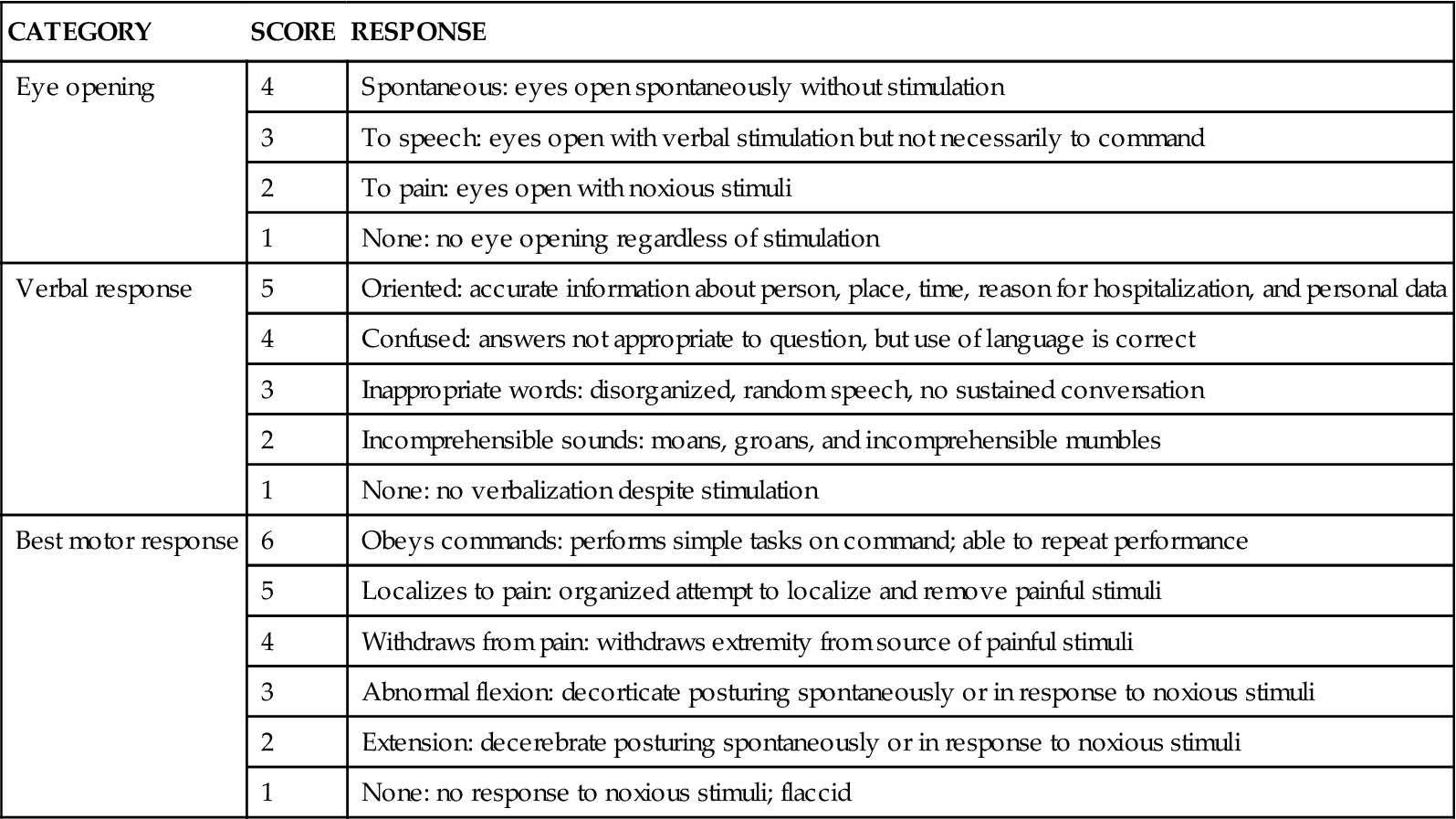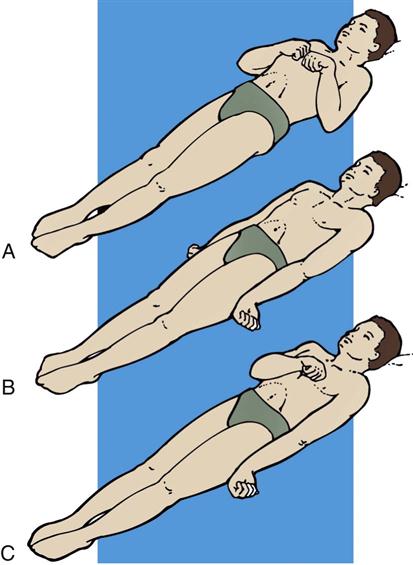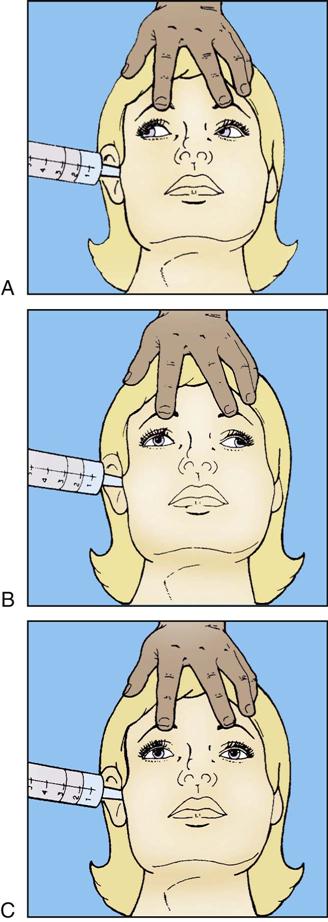Objectives
• Identify the components of a neurological history.
• Describe the five components of the neurological assessment.
• Discuss the neurological changes associated with intracranial hypertension.
• Identify key diagnostic procedures used in assessment of the patient with neurological dysfunction.
• Discuss the nursing management of a patient undergoing a neurological diagnostic procedure.
• Identify the different types of intracranial pressure monitoring devices.
![]()
Be sure to check out the bonus material, including free self-assessment exercises, on the Evolve web site at http://evolve.elsevier.com/Urden/priorities/.
Assessment of the critically ill patient with neurological dysfunction includes a review of the patient’s health history, a thorough physical examination, and an analysis of the patient’s laboratory data. Numerous invasive and noninvasive diagnostic procedures may be performed to assist in the identification of the patient’s disorder. This chapter focuses on clinical assessments, laboratory studies, and diagnostic procedures for the critically ill patient with a neurological dysfunction.
Clinical Assessment
A thorough clinical assessment of the patient with neurological dysfunction is imperative for the early identification and treatment of neurological disorders. The completed assessment is used for developing the management plan for the patient. The assessment process can be brief or can involve a detailed history and examination, depending on the nature and immediacy of the patient’s situation.
History
Neurological assessment encompasses a wide variety of applications and a multitude of techniques. This chapter focuses on the type of assessment performed in a critical care environment. Common to all neurological assessments is the need to obtain a comprehensive history of events preceding hospitalization. An adequate neurological history includes information about clinical manifestations, associated complaints, precipitating factors, progression, and familial occurrences. If the patient is incapable of providing this information, family members or significant others should be contacted as soon as possible. An ideal historian is able to provide detailed information with emphasis on the chronology of events. Valuable information is gained through medical history that assists the patient’s clinical assessment. When someone other than the patient is the source of the history, it should be an individual who was in contact with the patient on a daily basis. Frequently, valuable information is gained that directs the caregiver to focus on certain aspects of the patient’s clinical assessment.1
Physical Examination
Five major components make up the neurological evaluation of the critically ill patient. Nursing assessment priorities focus on evaluating (1) level of consciousness, (2) motor function, (3) pupillary function, (4) respiratory function, and (5) vital signs. A complete neurological examination requires assessment of all five components.1
Level of Consciousness
Assessment of the level of consciousness is the most important aspect of the neurological examination. In most situations, a patient’s level of consciousness deteriorates before any other neurological changes are noticed. These deteriorations often are subtle and must be monitored carefully. Nursing priorities in assessment of level of consciousness focus on (1) evaluating arousal or alertness and (2) appraising consciousness or awareness.1 Although universally accepted definitions for various levels of consciousness do not exist, the categories outlined in Box 17-1 are often used to describe the patient’s level of consciousness.1–4
Evaluating Arousal
Assessment of the arousal component of consciousness is an evaluation of the reticular activating system and its connection with the thalamus and the cerebral cortex. Arousal is the lowest level of consciousness, and observation centers on the patient’s ability to respond to verbal or noxious stimuli in an appropriate manner. To stimulate the patient, the nurse should begin with verbal stimuli in a normal tone. If the patient does not respond, the nurse should increase the stimuli by shouting at the patient. If the patient still does not respond, the nurse should further increase the stimuli by shaking the patient. Noxious stimuli should follow if previous attempts to arouse the patient are unsuccessful. To assess arousal, central stimulation should be used (Box 17-2).
Appraising Awareness
Content of consciousness is a higher-level function, and appraisal of awareness is concerned with assessment of the patient’s orientation to person, place, and time. Assessment of content of consciousness requires the patient to give appropriate answers to a variety of questions. Changes in the patient’s answers that indicate increasing degrees of confusion and disorientation may be the first sign of neurological deterioration.1,3,4
Glasgow Coma Scale
The most widely recognized level of consciousness assessment tool is the Glasgow Coma Scale (GCS).5 This scored scale is based on evaluation of three categories: eye opening, verbal response, and best motor response (Table 17-1). The best possible score on the GCS is 15, and the lowest score is 3. A score of 8 or less on the GCS usually indicates coma. Originally, the scoring system was developed to assist in general communication concerning the severity of neurological injury. Recent testing of the GCS revealed a moderate to high agreement rating among physicians and nurses.6,7 Several points should be kept in mind when the GCS is used for serial assessment. It provides data about level of consciousness only, and it never should be considered a complete neurological examination. It is not a sensitive tool for evaluation of an altered sensorium, nor does it account for possible aphasia. The GCS is also a poor indicator of lateralization of neurological deterioration.7 Lateralization involves decreasing motor response on one side or unilateral changes in pupillary reaction.
TABLE 17-1
| CATEGORY | SCORE | RESPONSE |
| Eye opening | 4 | Spontaneous: eyes open spontaneously without stimulation |
| 3 | To speech: eyes open with verbal stimulation but not necessarily to command | |
| 2 | To pain: eyes open with noxious stimuli | |
| 1 | None: no eye opening regardless of stimulation | |
| Verbal response | 5 | Oriented: accurate information about person, place, time, reason for hospitalization, and personal data |
| 4 | Confused: answers not appropriate to question, but use of language is correct | |
| 3 | Inappropriate words: disorganized, random speech, no sustained conversation | |
| 2 | Incomprehensible sounds: moans, groans, and incomprehensible mumbles | |
| 1 | None: no verbalization despite stimulation | |
| Best motor response | 6 | Obeys commands: performs simple tasks on command; able to repeat performance |
| 5 | Localizes to pain: organized attempt to localize and remove painful stimuli | |
| 4 | Withdraws from pain: withdraws extremity from source of painful stimuli | |
| 3 | Abnormal flexion: decorticate posturing spontaneously or in response to noxious stimuli | |
| 2 | Extension: decerebrate posturing spontaneously or in response to noxious stimuli | |
| 1 | None: no response to noxious stimuli; flaccid |

Motor Function
Nursing priorities in assessment of motor function focus on (1) evaluating muscle size and tone and (2) estimating muscle strength. Each side should be assessed individually and then compared with the other.1,8
Evaluating Muscle Size and Tone
Initially, the muscles should be inspected for size and shape. The presence of atrophy is noted. Muscle tone is assessed by evaluating the opposition to passive movement. The patient is instructed to relax the extremity while the nurse performs passive range-of-motion movements and evaluates the degree of resistance. Muscle tone is appraised for signs of flaccidity (no resistance), hypotonia (little resistance), hypertonia (increased resistance), spasticity, or rigidity.8
Estimating Muscle Strength
Having the patient perform a number of movements against resistance assesses muscle strength. The strength of the movement is then graded on a 6-point scale (Box 17-3). Ask the patient to extend both arms with the palms turned upward and to hold that position with the eyes closed. If the patient has a weaker side, that arm will drift downward and pronate. The lower extremities are tested by asking the patient to push and pull the feet against resistance or to elevate the legs.9,10
Abnormal Motor Responses
If the patient is incapable of comprehending and following a simple command, noxious stimuli are necessary to determine motor responses. The stimulus is applied to each extremity separately to allow evaluation of individual extremity function. Peripheral stimulation is used to assess motor function (see Box 17-2).1,2 Motor responses elicited by noxious stimuli are interpreted differently from those elicited by voluntary demonstration. These responses may be classified as shown in Box 17-4.8
Abnormal flexion also is known as decorticate posturing (see Figure 17-1, A). In response to painful stimuli, the upper extremities exhibit flexion of the arm, wrist, and fingers with adduction of the limb. The lower extremity exhibits extension, internal rotation, and plantar flexion. Abnormal flexion occurs with lesions above the midbrain, located in the region of the thalamus or cerebral hemispheres. Abnormal extension also is known as decerebrate rigidity or posturing (see Figure 17-1, B); when the patient is stimulated, teeth clench, and the arms are stiffly extended, adducted, and hyperpronated. The legs are stiffly extended with plantar flexion of the feet. Abnormal extension occurs with lesions in the area of the brainstem. Because abnormal flexion and extension appear similar in the lower extremities, the upper extremities are used to determine the presence of these abnormal movements. It is possible for the patient to exhibit abnormal flexion on one side of the body and extension on the other (see Figure 17-1, C).1–3 Outcome studies indicate that abnormal flexion or decorticate posturing has a less serious prognosis than does extension, or decerebrate posturing. Onset of posturing or a change from abnormal flexion to abnormal extension requires immediate physician notification.3
Pupillary Function
Nursing priorities in assessment of pupillary function focus on (1) estimating pupil size and shape, (2) evaluating pupillary reaction to light, and (3) assessing eye movements. Pupillary function is an extension of the autonomic nervous system. Parasympathetic control of the pupil occurs through innervation of the oculomotor nerve (CN III), which exits from the brainstem in the midbrain area. When the parasympathetic fibers are stimulated, the pupil constricts. Sympathetic control originates in the hypothalamus and travels down the entire length of the brainstem. When the sympathetic fibers are stimulated, the pupil dilates. Pupillary changes provide a valuable assessment tool because of pathway locations. The oculomotor nerve lies at the junction of the midbrain and the tentorial notch. Any increase of pressure that exerts force down through the tentorial notch compresses the oculomotor nerve. Oculomotor nerve compression results in a dilated, nonreactive pupil. Sympathetic pathway disruption occurs with involvement in the brainstem. Loss of sympathetic control leads to pinpoint, nonreactive pupils. Control of eye movements occurs with interaction of three cranial nerves: oculomotor (CN III), trochlear (CN IV), and abducens (CN VI). The pathways for these cranial nerves provide integrated function through the internuclear pathway of the medial longitudinal fasciculus (MLF) located in the brainstem. The MLF provides coordination of eye movements with the vestibular nerve (CN VIII) and the reticular formation.3
Estimating Pupil Size and Shape
Pupil diameter should be documented in millimeters with the use of a pupil gauge to reduce the subjectivity of description. Most people have pupils of equal size, between 2 and 5 mm. A discrepancy up to 1 mm between the two pupils is normal; it is called anisocoria and occurs in 16% to 17% of the human population.11 Change or inequality in pupil size, especially in patients who previously have not shown this discrepancy, is a significant neurological sign. It may indicate impending danger of herniation and should be reported immediately. With the location of the oculomotor nerve (CN III) at the notch of the tentorium, pupil size and reactivity play a key role in the physical assessment of intracranial pressure (ICP) changes and herniation syndromes. In addition to CN III compression, changes in pupil size occur for other reasons. Large pupils can result from the instillation of cycloplegic agents, such as atropine or scopolamine, or can indicate extreme stress. Extremely small pupils can indicate opioid overdose, lower brainstem compression, or bilateral damage to the pons.11,12
Pupil shape is included in the assessment of pupils. Although the pupil is normally round, an irregularly shaped or oval pupil may be observed in patients who have undergone eye surgery. Initial stages of CN III compression from elevated ICP can cause the pupil to have an oval shape.1,11
Evaluating Pupillary Reaction to Light
The pupillary light reflex depends on optic nerve (CN II) and oculomotor nerve (CN III) function (Figure 17-2).3,11 The technique for evaluation of the pupillary light response involves use of a narrow-beamed bright light shined into the pupil from the outer canthus of the eye. If the light is shined directly onto the pupil, glare or reflection of the light may prevent the assessor’s proper visualization. Pupillary reaction to light is identified as brisk, sluggish, or nonreactive or fixed.1 Each pupil should be evaluated for direct light response and for consensual response. The consensual pupillary response is constriction in response to a light shined into the opposite eye. This reflex occurs as a result of the crossing of nerve fibers at the optic chiasm.1 Evaluation of consensual response is necessary to rule out optic nerve dysfunction as a cause for lack of a direct light reflex. Because the optic nerve is the afferent pathway for the light reflex, shining a light into a blind eye produces neither a direct light response in that eye nor a consensual response in the opposite eye. A consensual response in the blind eye produced by shining a light into the opposite eye demonstrates an intact oculomotor nerve. Oculomotor compression associated with transtentorial herniation affects the direct light response and the consensual response in the affected pupil.1,2,11,12
Assessing Eye Movement
In the conscious patient, the function of the three cranial nerves of the eye and their MLF innervation can be assessed by asking the patient to follow a finger through the full range of eye motion. If the eyes move together into all six fields, extraocular movements are intact (Figure 17-3).1
In the unconscious patient, assessment of ocular function and innervation of the MLF is performed by eliciting the doll’s eyes reflex. If the patient is unconscious as a result of trauma, the nurse must ascertain the absence of cervical injury before performing this examination. To assess the oculocephalic reflex, the nurse holds the patient’s eyelids open and briskly turns the head to one side while observing the eye movements and then briskly turns the head to the other side and observes. If the eyes deviate to the opposite direction in which the head is turned, the doll’s eyes reflex is present, and the oculocephalic reflex arc is intact (Figure 17-4, A). If the oculocephalic reflex arc is not intact, the reflex is absent. This lack of response, in which the eyes remain midline and move with the head, indicates significant brainstem injury (Figure 17-4, C). The reflex may also be absent in severe metabolic coma. An abnormal oculocephalic reflex is present when the eyes rove or move in opposite directions from each other (Figure 17-4, B). Abnormal oculocephalic reflex indicates some degree of brainstem injury.1–3
The oculovestibular reflex is performed by a physician, often as one of the final clinical assessments of brainstem function. After confirmation that the tympanic membrane is intact, the head is raised to a 30-degree angle, and 20 to 100 mL of ice water is injected into the external auditory canal. The normal eye movement response is a conjugate, slow, tonic nystagmus deviating toward the irrigated ear and lasting 30 to 120 seconds. This response indicates brainstem integrity. Rapid nystagmus returns the eyes back to the midline only in a conscious patient with cortical functioning (Figure 17-5).1 An abnormal response is disconjugate eye movement, which indicates a brainstem lesion, or no response, which indicates little or no brainstem function. The oculovestibular reflex may be temporarily absent in reversible metabolic encephalopathy.3 This test is an extremely noxious stimulation and may produce a decorticate or decerebrate posturing response in a comatose patient. In the conscious patient, this procedure may produce nausea, vomiting, or dizziness.1,12
Respiratory Function
Nursing priorities in assessment of respiratory function focus on (1) observing respiratory pattern and (2) evaluating airway status.











